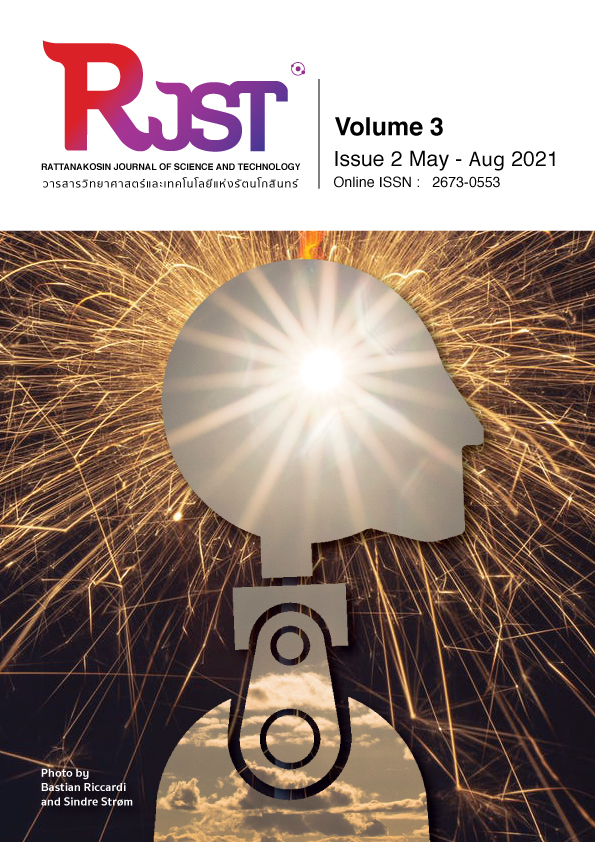Chemical activation effect on activated carbon prepared from pineapple leaves
Main Article Content
Abstract
Activated carbon (AC) was prepared from pineapple leaves carbonized in the local kiln. The effects of the main variables involved in the reaction, temperature, time of reaction, and the pineapple leaves/acid ratio, were studied. In this work, the iodine adsorption number (IAN) standard method was studied to indicate its physical properties. Brunauer Emmett Teller (BET) was used to analyses the surface area and also pore size. The functional groups were obtained by using the Fourier Transform Infrared Spectrometer (FT-IR). The results indicated that as temperature increased the IAN and surface areas were increased. The suitable conditions for AC preparation was 700 ºC at 1:1 g/ml of AC: acid with soaking time 3 hr., resulting in IAN and surface area of 251.67 mg/g and 254.49 m2/g, respectively. The increment of IAN and surface area are 106 and 200 times comparison with carbonized pineapple leaves.
Article Details
The content within the published articles, including images and tables, is copyrighted by Rajamangala University of Technology Rattanakosin. Any use of the article's content, text, ideas, images, or tables for commercial purposes in various formats requires permission from the journal's editorial board.
Rajamangala University of Technology Rattanakosin permits the use and dissemination of article files under the condition that proper attribution to the journal is provided and the content is not used for commercial purposes.
The opinions and views expressed in the articles are solely those of the respective authors and are not associated with Rajamangala University of Technology Rattanakosin or other faculty members in the university. The authors bear full responsibility for the content of their articles, including any errors, and are responsible for the content and editorial review. The editorial board is not responsible for the content or views expressed in the articles.
References
[2] Demirbas. A. (2008). Heavy metal adsorption onto agro-based waste materials: A review. Journal of hazardous materials, 157, 220-229.
[3] De Gisi, S., Lofrano, G., Grassi, M., & Notarnicola, M. (2016) Characteristics and adsorption capacities of low-cost sorbents for wastewater treatment: A review. Sustainable Materials and Technologies, 9, 10–40.
[4] Kyzas, G. Z., & Kostoglou, M. (2014). Green Adsorbents for Wastewaters: A Critical Review. Materials, 7, 364-333.
[5] Foo, K. Y., & Hameed, B. H. (2012). Porous structure and adsorptive properties of pineapple peel based activated carbons prepared via microwave assisted KOH and K2CO3 activation. Microporous and Mesoporous Materials, 148(1), 191-195.
[6] Mahamad, M. N., Zaini, M. A. A., & Zakaria, Z. A. (2015). Preparation and characterization of activated carbon from pineapple waste biomass for dye removal. International Biodeterioration & Biodegradation, 102, 274-280.
[7] Mopoung, S., & Amornsakchai. P. (2016). Microporous activated carbon fiber from pineapple leaf fiber by H3PO4 activation. Asian journal of scientific research, 9, 24-33.
[8] González-García, P. (2018). Activated carbon from lignocellulosics precursors: A review of the synthesis methods, characterization techniques and applications. Renewable and Sustainable Energy Reviews, 82, 1393-1414.
[9] Mohan, D., Singh, K. P., & Singh, V. K. (2008). Waste water treatment using low cost activated carbons derived from agricultural byproducts—A case study. Journal of hazardous materials, 152, 1045–1053.
[10] Ceyhan, A. A., Şahin, Ö., Baytar, O., & Saka, C. (2013). Surface and porous characterization of activated carbon prepared from pyrolysis of biomass by two-stage procedure at low activation temperature and it's the adsorption of iodine. Journal of Analytical and Applied Pyrolysis, 104, 378-383.
[11] Şahin, Ö., Saka, C., Ceyhan, A. A., & Baytar, O. (2016). The pyrolysis process of biomass by two-stage chemical activation with different methodology and iodine adsorption. Energy Sources, Part A: Recovery, Utilization, and Environmental Effects, 38(12), 1756-1762.


